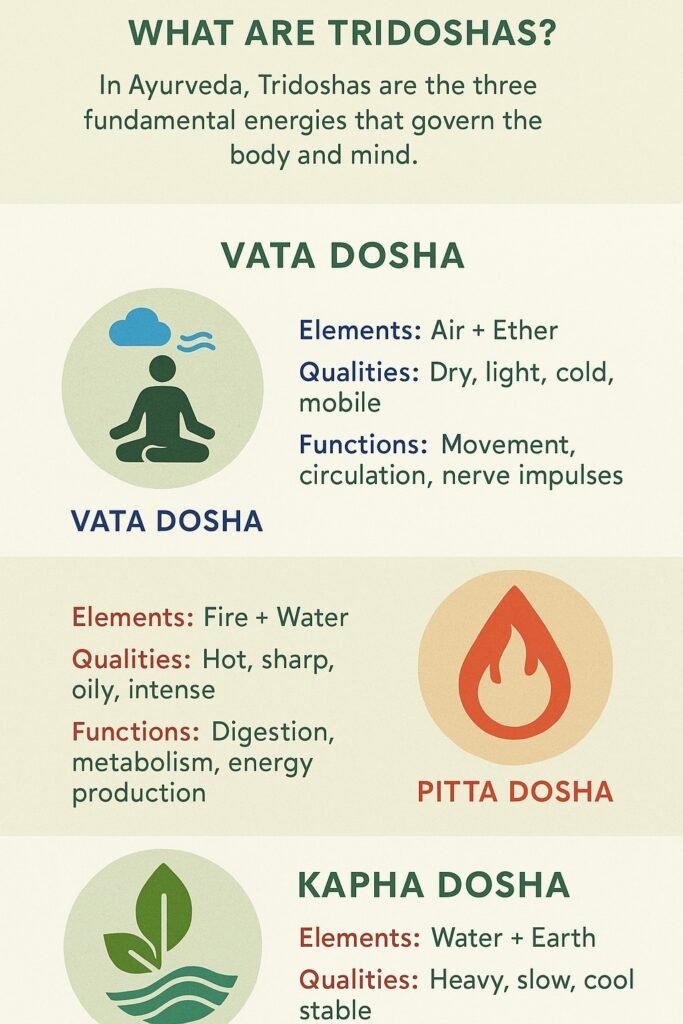
Ayurveda, the timeless science of life, teaches us that true health goes beyond simply being disease-free — it means living in balance with yourself and in sync with the rhythms of the universe. One of the most fascinating and foundational concepts in Ayurveda is the Tridosha theory.
If you’ve ever wondered why some people thrive on spicy food while others break into a sweat just by looking at it — or why your friend can stay up all night and feel fresh in the morning while you turn into a zombie after missing just two hours of sleep — the answer lies in the Tridoshas.
So, let’s dive deep into this ancient wisdom and see how understanding your Doshas can transform your health, happiness, and everyday life.
What Are Tridoshas?
The word Tridosha comes from Sanskrit: Tri means three, and Dosha means that which can go out of balance. According to Ayurveda, the human body is governed by three fundamental energies or bio-elements:
- Vata (Air + Ether)
- Pitta (Fire + Water)
- Kapha (Water + Earth)
Each Dosha represents a combination of the five universal elements (Panchamahabhuta) and governs specific physical and mental processes in the body.
Meet the Doshas: Vata, Pitta, and Kapha
Let’s get to know them one by one — like meeting three roommates who share your body and mind.
1️⃣ Vata Dosha: The Mover and Shaker
Elements: Air and Ether
Qualities: Dry, light, cold, rough, mobile, subtle
Functions: Movement, circulation, nerve impulses, breathing, elimination
Vata is the energy of movement. It’s what keeps your heart beating, your lungs breathing, and your thoughts flowing. People whose Vata dosha is prominent are typically vibrant, quick thinkers, highly creative, and brimming with enthusiasm. They’re the ones bursting with ideas but sometimes struggle to follow through.
When Vata is balanced: You feel lively, inspired, flexible, and full of vitality.
When Vata is out of balance: You may feel anxious, scattered, have dry skin, constipation, or insomnia.
How to keep Vata balanced:
- Favor warm, hydrating, and grounding foods like rich soups and slow-cooked stewsFollow a regular routine — Vata people thrive on structure.
- Stay warm and avoid excessive travel and overstimulation.
- Practice calming activities like gentle yoga, meditation, and oil massages.
2️⃣ Pitta Dosha: The Fire Within
Elements: Fire and Water
Qualities: Hot, sharp, oily, light, intense, fluid
Functions: Digestion, metabolism, energy production, intellect
Pitta governs your digestion and transformation processes — both physically (digesting food) and mentally (digesting ideas). Ambitious, insightful, and goal-oriented, Pitta types naturally excel as leaders.
When Pitta is balanced: You feel sharp, courageous, enthusiastic, with a strong digestion and clear skin.
When Pitta is out of balance: You may feel irritable, aggressive, overheated, suffer from heartburn, ulcers, rashes, or inflammation.
How to keep Pitta balanced:
- Eat cooling, refreshing foods like salads, cucumbers, melons.
- Avoid too much heat — both physically and emotionally.
- Take time to relax; don’t push yourself to burn out.
- Practice soothing activities like swimming, nature walks, or moonlight strolls.
3️⃣ Kapha Dosha: The Stable Supporter
Elements: Water and Earth
Qualities: Heavy, slow, steady, soft, cold, oily, smooth
Functions: Structure, lubrication, immunity, growth
Kapha is the glue that holds the body together. It provides strength, stability, and endurance. Those with a strong Kapha constitution tend to be tranquil, kind-hearted, devoted, and supportive. They have strong frames and great stamina but may resist change.
When Kapha is balanced: You feel patient, loving, grounded, with strong immunity and good sleep.
When Kapha is out of balance: You may feel sluggish, gain weight easily, experience congestion, or feel overly attached and resistant to change.
How to keep Kapha balanced:
- Choose light, warm, and mildly spicy foods, and steer clear of heavy or greasy meals
- Stay active and embrace variety in your routine.
- Avoid oversleeping and laziness.
- Engage in stimulating activities, dance, or invigorating exercises.
Why Do Tridoshas Matter in Daily Life?
Understanding your Dosha is like having a personalized health manual. Instead of a one-size-fits-all solution, Ayurveda gives you custom advice to thrive.
Examples:
- If you’re Vata dominant, skip raw salads in winter — eat hearty soups instead.
- If you’re Pitta dominant, don’t overdo spicy curries during hot summers.
- If you’re Kapha dominant, don’t snooze your alarm for the tenth time — get up and move!
When you live according to your Dosha’s needs, you naturally prevent imbalances that could lead to diseases.
Discovering Your Prakriti: The Dosha Constitution
Everyone has all three Doshas, but in different proportions. This unique combination is called your Prakriti — your natural constitution.
- Few people might be dominated by single dosha, like pure Pitta.
- Some are dual Dosha types, like Vata-Pitta or Pitta-Kapha.
- Rarely, some are Tridoshic — an even mix of all three.
Your Prakriti is determined at conception and stays constant throughout your life. It explains why siblings can have completely different personalities and health tendencies despite the same upbringing.
Vikriti: The Current State of Balance
Think of Prakriti as your inherent nature and Vikriti as the snapshot of your Doshas in their current state
- Your Prakriti might be Pitta dominant.
- But if you’re stressed, overeating spicy food, and working non-stop, your Pitta may spike higher than normal — that’s a Vikriti.
Ayurvedic healing aims to bring your Vikriti back in line with your Prakriti.
🪔 Balancing the Doshas: Simple Tips
Here are some easy, practical ways to keep your Doshas balanced:
For Vata:
✅ Eat warm, cooked foods
✅ Drink herbal teas like ginger or licorice
✅ Practice self-massage with sesame oil
✅ Keep warm and cozy
For Pitta:
✅ Avoid excessive heat and spicy foods
✅ Include coconut water, mint, and coriander
✅ Spend time near water bodies
✅ Practice cooling pranayama like Sheetali
For Kapha:
✅ Eat light, dry, and warming foods
✅ Few spices are good for you like black pepper, ginger, and turmeric
✅ Exercise daily, even when you feel lazy
✅ Try new hobbies to break monotony
🧘 Yoga and Tridoshas
Ayurveda and Yoga go hand in hand. Yoga literally meaning in tune with that cosmos , you can choose right yoga for you self, depending on which dosha you are dominated by:
- Vata: Gentle, grounding poses like child’s pose, seated forward bends, and slow Sun Salutations.
- Pitta: Cooling, relaxing poses like twists, forward folds, and moon salutations.
- Kapha: Energizing, stimulating poses like backbends, standing balances, and fast-paced vinyasa.
🍯 Herbs for Each Dosha
Mother Nature has blessed us with a treasure trove of herbs to maintain Dosha balance:
- Vata: Ashwagandha, licorice, sesame oil.
- Pitta: Neem, aloe vera, Brahmi.
- Kapha: Ginger, turmeric, black pepper.
💬 Real-Life Example
Let’s meet Aarti, a 35-year-old working mom.
Aarti’s Prakriti is Vata-Pitta. She loves her creative job but often skips meals, drinks too much coffee, and stays up late scrolling her phone.
What happens? Her Vata goes haywire — she feels anxious, has dry skin, constipation, and can’t sleep.
Her Ayurvedic consultant suggests:
- Regular meals with warm soups and khichdi.
- Less caffeine, more herbal teas.
- A fixed bedtime with an oil massage.
Within weeks, Aarti feels calmer, sleeps better, and her digestion improves — all by realigning her Doshas!
🌱 Tridoshas and Modern Life
In our fast-paced world, Dosha imbalances are very common. Constant stress, irregular sleep, processed foods, and screens disrupt the natural balance.
Ayurveda doesn’t ask you to give up your modern life. It simply invites you to align your choices with nature’s wisdom.
Small changes make a big difference:
- Mindful eating
- Good sleep hygiene
- Daily self-care rituals
- Listening to your body’s signals
✨ Key Takeaways
✅ You are unique: There’s no perfect Dosha — only perfect balance for you.
✅ Nature is your guide: Eat seasonally, live mindfully.
✅ Small steps matter: Even minor changes in diet and routine can prevent major health issues.
✅ Ayurveda stands the test of time, seamlessly supporting modern needs, whether it’s gut health or mental wellness
📚 Final Thoughts
Understanding Tridoshas isn’t just ancient theory — it’s a practical life tool. It empowers you to take charge of your health, respect your body’s needs, and live with more joy and less struggle.
So, next time you feel tired, bloated, or cranky, don’t just pop a pill — pause and ask yourself: Which Dosha is out of balance? Then give your body what it truly needs.
Your body is wise. Listen to it. Love it. And let Ayurveda guide you to a balanced, vibrant life.
✨ Did this article help you understand your Doshas better? Share your Dosha type in the comments and let’s build a community of mindful living together! 🌿💚
Top of Form
Bottom of Form
